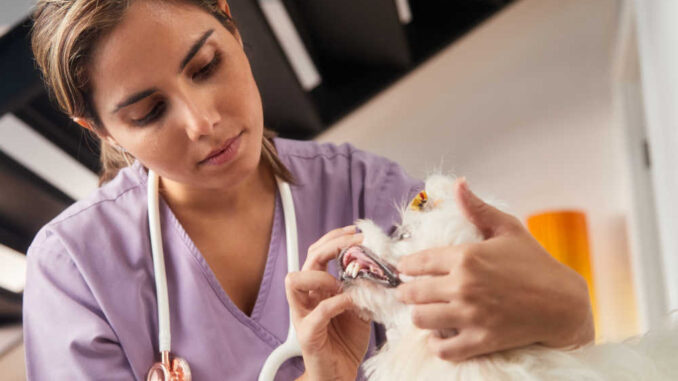
This article was updated on January 29th, 2024
Performing a thorough oral exam is a really important part of a dog’s physical exam, and is something I will try and perform every time I see a dog for a checkup. This is especially crucial because many owners won’t regularly look inside their dog’s mouth and new issues can easily go overlooked. On this page, I will explain the top causes of black spots on gums, and when you should be concerned.
For most dogs, the normal gum color is salmon pink. But some dogs have black gums [pictures]
For the majority of dogs, we expect their gums to be a salmon pink color. In general, this won’t change as they get older. While dogs can develop some pigmented spots that are black, they should still continue to have some areas of gum where we can assess the ‘true’ gum color.
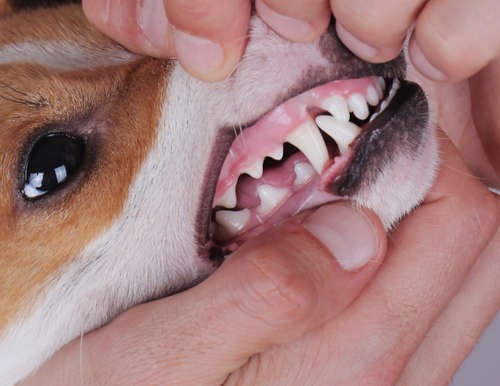
Certain breeds, however, will naturally have a more dark blue or black color on their gums and tongues. This is true for breeds including the Chow Chow and Shar Pei. This can make it a little trickier to assess their circulation and oral health.
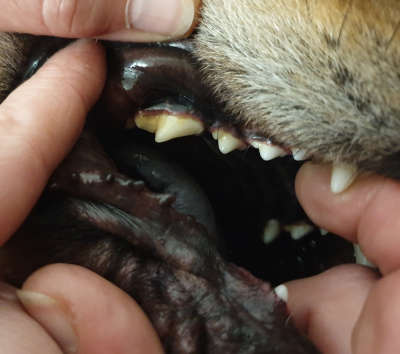
Normal black spots on gums:
For the vast majority of our canine companions, black spots on their gums are simply a buildup of pigment, which can be present from birth or can develop as a dog ages. This pigment causes no problems for the pet and requires no treatment. One example is provided with the picture below:
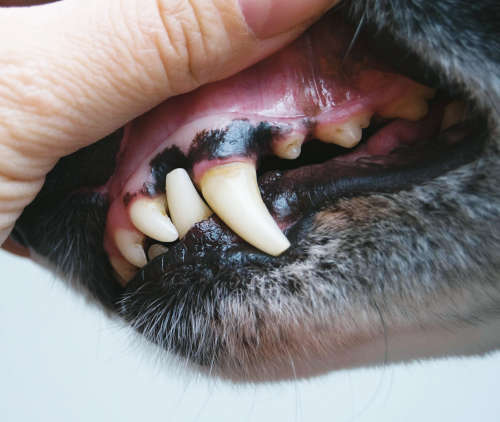
You should be concerned if a new black spot is raised or changing
It is always a sensible idea to familiarize yourself with what your dog’s gums look like, so any changes can be detected more rapidly. If they’ve always had dark, pigmented spots then we know that these are nothing to be concerned about. However, you should be concerned if you notice:
- A new spot that appeared suddenly
- A black spot that is raised or has an irregular surface (normal gum pigmentation should be flat).
- A black spot that is changing or ‘evolving’ is more likely to be something sinister (in particular if the lesion is also ulcerating, bleeding or becoming infected)
- Your dog’s gums do not look like they normally do
Example of worrisome black spots or lumps on a dog’s gums or lips:
See pictures below showing abnormal black spots or bumps. You can also see this example on NDSR.co.uk.
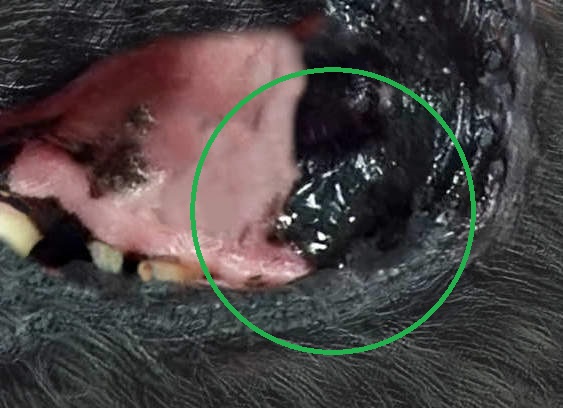
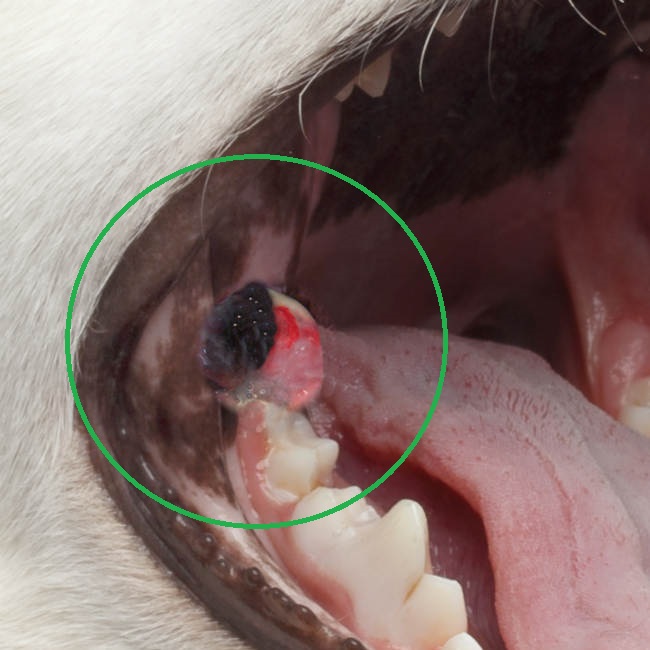
What are the causes of black spots on dog’s gum?
1. Pigmentation
By far the most common cause of black spots in the gums is a buildup of a dark pigment called melanin. This is normal and of no concern. Pigment spots can be present from birth but can also develop as a dog ages. In the photo below, we can see that this dog has salmon pink gums, as well as a good amount of normal, dark pigmentation:
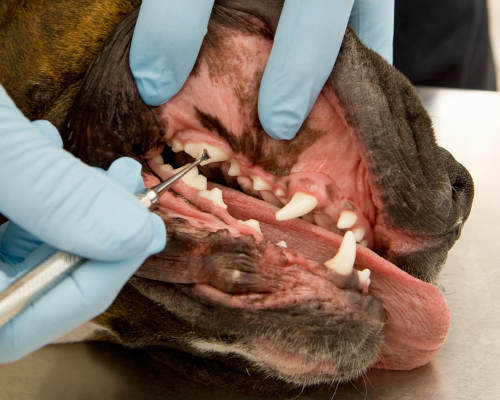
These spots don’t cause the dog any discomfort and will not bleed or ulcerate. They tend to remain the same over a dog’s lifetime. Dogs with dark skin and fur are more likely to have them. As oral pigmentation is genetic, you’ll likely find your pooch’s parents and/or siblings have similar spots inside their mouths.
2. Periodontal disease
When dogs have black spots or dark buildup along the gum line, alongside other symptoms such as bad breath and bleeding gums, it is likely they have periodontal disease. Periodontal disease is very common: 80% of dogs over the age of 2 have some form of the disease, according to Today’s Veterinary Practice magazine.
Pictures of periodontal or dental disease:
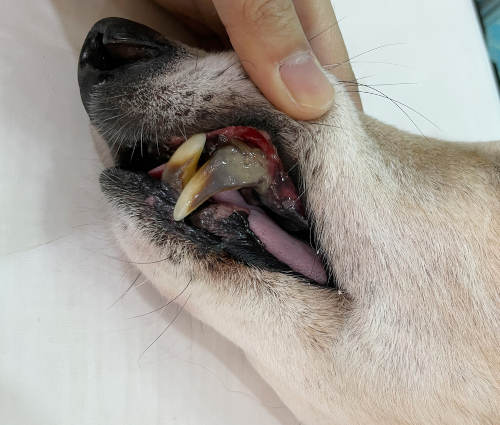
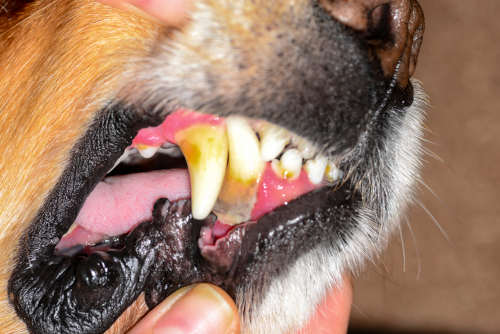
Gum disease would usually be something that affects several teeth, rather than being confined to one location. Once gum disease is established, veterinary intervention is needed. This will typically involve a dental cleaning and some anti-inflammatories and antibiotics. This may include dental extractions, if the disease has progressed.
After the gum disease has been professionally treated, owners can prevent it by brushing teeth daily and feeding hard kibble. There are also plaque reducing products on the market such as Plaque Off. Read our article about the best ways to reduce tartar in dogs.
3. Oral melanoma
Melanoma is a cancer that can present as dark, black lesions. Indeed, melanoma is the most common malignant tumor we see in canine mouths. These growths tend to be aggressive, and to spread quickly. Learn about Canine Oral Melanoma on ScienceDirect.com or view our melanoma pictures (with vet advice).
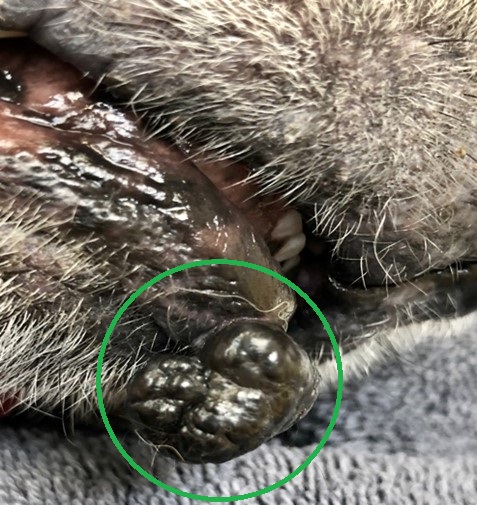
Photo: Ian Spiegel DACVD
Melanomas can grow from any part of the mouth as darkened nodules or areas of thickening. They may seem quite small, but are often larger under the surface. For some dogs, there is also swelling around the mouth due to boney involvement.
Diagnosis: If an owner spots a lesion they think could potentially be a melanoma, the sooner they have their dog checked over the better. Vets should grade the cancer by taking an FNA or biopsy and they can then determine if it has spread by using imaging tools and sampling local lymph nodes.
Treatment: treatment typically consists of surgical removal of the growth, as well as chemotherapy and radiotherapy where needed. Read our article about common Lumps Often Found Inside a Dog’s Mouth.
Frequently Asked Questions
Can black spots on gums be a sign of infection?
Black spots can potentially indicate dental disease and a localized infection. When this is the case, there will be other symptoms including gingivitis (gum inflammation) and halitosis (bad breath).
Can a dog develop pigment on their gums when they’re older?
Absolutely. While many dogs are born with pigmentation in their mouth, it is normal for pigment to develop and darken as a dog ages. This happens both in their mouth and on their skin.
Related posts:
- Black Spots on a Dog’s Skin: Our Veterinarians Explains Top Causes & What to Do.
- Black or Brown Spots on a Dog’s Belly.
Disclaimer: This website's content is not a substitute for veterinary care. Always consult with your veterinarian for healthcare decisions. Read More.


Be the first to comment